Water Field Distribution Characteristics under Slope Runoff and Seepage Coupled Effect Based on the Finite Element Method
Abstract
:1. Introduction
2. Methodologies
2.1. Framework
2.2. Theoretical Equations
2.2.1. SR Governing Equation
2.2.2. Rainfall Infiltration Equation
- (1)
- UF governing equation
- (2)
- MF governing equation
2.2.3. Coupled Process
- (a)
- The I calculated above is substituted into Equation (1), and H is obtained.
- (b)
- The H obtained in step (a) is taken as the upper boundary condition of Equation (7), and then Equation (7) can be solved.
- (c)
- After solving Equation (7), I can be calculated according to step (a), and Equation (1) can be recalculated with I to solve H.
- (d)
- Equation (7) is solved by using H obtained in (c) as the upper boundary condition of Equation (7).
- (e)
- Steps (a)–(d) are repeated until Equations (1) and (7) converge.
- (f)
- Steps (a)–(e) are repeated until the end.
2.3. Model Test
2.3.1. Test Slope Model
2.3.2. Testing Apparatus
2.3.3. Test Procedure
2.4. COMSOL PDE Calculation and Solution
2.5. Model Validation
3. Case Analysis
3.1. Water Content Distribution
3.2. Ponding Depth Distribution
4. Discussion
- (1)
- The coupled model of Slope Runoff and infiltration solved by the COMSOL has high accuracy, which can be mutually verified with the experimental results. The influence of rainfall intensity on the water infiltration of UF and MF is minimal when runoff is considered, which is quite different from the result with the slope as the flow boundary when SR is not considered. With a longer rainfall duration, the depth of the saturated zone and wetting front increases.
- (2)
- Permeability has a positive effect on the infiltration results, while the slope roughness coefficient has no direct relationship with the infiltration equation, thus having a weak effect on water infiltration. By comparing UF and MF, it is found that the depth of the saturation zone and wetting front of MF is remarkably higher than that of UF, which is mainly due to the high conductivity of the macropore channel. Therefore, macropores and their effects on the water infiltration depth should not be ignored when they exist in a slope.
- (3)
- Rain intensity has a significant influence on ponding depth in slope areas. When the rain intensity increases, the ponding depth will rise, but the length of the stable area will be reduced. However, the difference between UF and MF ponding depth is not apparent. Rainfall duration may affect the ponding depth only when the rainfall duration is small, and the ponding depth is positively correlated with the rainfall duration. In addition, with a shorter duration, the stable area of the slope becomes longer. The difference in ponding depth between UF and MF increased first and then decreased with rainfall duration, and they were almost the same eventually.
- (4)
- With the increase of saturated conductivity, the ponding depth decreased slightly, but the water depth of MF increased successively along the slope, while a stable area appeared in UF. Compared with UF, the ponding in MF slope was more difficult to reach a stable state. Ponding depth increases significantly with the increase of roughness coefficient. When the roughness coefficient is small, UF and MF have no significant difference. When the roughness coefficient reaches a certain level, the depth of MF ponding is significantly less than that of UF. The reason is that it is difficult to drain along the slope in a short period, and there is enough time for infiltration along the macropores channels.
- (5)
- In the actual situation, the SR is generated after a certain period of rainfall, and the critical time for runoff must be calculated. The boundary conditions of the slope surface should be determined according to the relationship between the rainfall duration and the critical time. Considering that the rainfall type in this study is heavy rainfall, the slope generates runoff in a short period, and the critical time of the runoff is ignored, making this study deviate from the actual situation. Therefore, the water infiltration depth should be investigated in future studies.
Author Contributions
Funding
Institutional Review Board Statement
Informed Consent Statement
Data Availability Statement
Conflicts of Interest
References
- Clague, J.; Stead, D. Landslides: Types, Mechanisms and Modeling; Cambridge University Press: Cambridge, UK, 2012. [Google Scholar]
- Lazzari, M.; Piccarreta, M.; Ray, R.; Manfreda, S. Modeling Antecedent Soil Moisture to Constrain Rainfall Thresholds for Shallow Landslides Occurrence. In Landslides: Investigation and Monitoring; IntechOpen: London, UK, 2020; pp. 1–32. [Google Scholar] [CrossRef]
- Lazzari, M.; Piccarreta, M.; Manfreda, S. The role of antecedent soil moisture conditions on rainfall-triggered shallow landslides. Nat. Hazards Earth Syst. Sci. 2018, 1–11. [Google Scholar] [CrossRef] [Green Version]
- Lazzari, M.; Piccarreta, M.; Capolongo, D. Landslide Triggering and Local Rainfall Thresholds in Bradanic Foredeep, Basilicata Region (Southern Italy). In Landslide Science and Practice; Springer: Berlin/Heidelberg, Germany, 2013. [Google Scholar] [CrossRef]
- Sun, L.; Ma, B.; Pei, L.; Zhang, X.; Zhou, J. The relationship of human activities and rainfall-induced landslide and debris flow hazards in Central China. Nat. Hazards 2021, 9, 147–169. [Google Scholar] [CrossRef]
- Springman, S.; Thielen, A.; Kienzler, P.; Friedel, S. A long-term field study for the investigation of rainfall-induced landslides. Geotechnique 2013, 63, 1177–1193. [Google Scholar] [CrossRef]
- Mukhlisin, M.; Taha, M.; Kosugi, K. Numerical analysis of effective soil porosity and soil thickness effects on slope stability at a hillslope of weathered granitic soil formation. Geosci. J. 2008, 12, 401–410. [Google Scholar] [CrossRef]
- Xie, M.; Esaki, T.; Cai, M. A time-space based approach for mapping rainfall-induced shallow landslide hazard. Environ. Geol. 2004, 46, 840–850. [Google Scholar] [CrossRef]
- Collins, B.; Znidarcic, D. Stability analyses of rainfall induced landslides. J. Geotech. Geoenviron. Eng. 2004, 130, 362–372. [Google Scholar] [CrossRef]
- Liu, J.; Yang, C.; Gan, J.; Liu, Y.; Liu, W.; Qiang, X. Stability analysis of road embankment slope subjected to rainfall considering runoff-unsaturated seepage and unsaturated fluid–solid coupling. Int. J. Civ. Eng. 2017, 15, 865–876. [Google Scholar] [CrossRef] [Green Version]
- Chiu, Y.; Chen, H.; Yeh, K. Investigation of the influence of rainfall runoff on shallow landslides in unsaturated soil using a mathematical model. Water 2019, 11, 1178. [Google Scholar] [CrossRef] [Green Version]
- Yang, Y.; Bao, H.; Peng, T. Verification and analysis of meteorological early warning of geological hazards during precipitation of Typhoon “MEGI”. Torrential Rain Disasters 2019, 38, 221–228. [Google Scholar]
- Cuomo, S.; Sala, M. Rainfall-induced infiltration, runoff and failure in steep unsaturated shallow soil deposits. Eng. Geol. 2013, 162, 118–127. [Google Scholar] [CrossRef]
- Kean, J.; McCoy, S.; Tucker, G.; Staley, D.; Coe, J. Runoff-generated debris flows: Observations and modeling of surge initiation, magnitude, and frequency. J. Geophys. Res. Earth Surf. 2013, 118, 2190–2207. [Google Scholar] [CrossRef]
- Wei, Z.; Shang, Y.; Yu, Z.; Pan, P.; Jiang, Y. Rainfall threshold for initiation of channelized debris flows in a small catchment based on in-site measurement. Eng. Geol. 2016, 217, 23–34. [Google Scholar] [CrossRef]
- Hua, Z.; Feng, Z.; Ke, S.; Mi, Y. A Surface and Subsurface Model for the Simulation of Rainfall Infiltration in Slopes. In IOP Conference Series: Earth and Environmental Science International Symposium on Geohazards and Geomechanics, Proceedings of the International Symposium on Geohazards and Geomechanics (ISGG2015), Warwick, UK, 10–11 September 2015; IOP Publishing: London, UK, 2015. [Google Scholar]
- Tian, D.; Zheng, H.; Liu, D. A 2D integrated FEM model for surface water–groundwater flow of slopes under rainfall condition. Landslides 2016, 14, 577–593. [Google Scholar] [CrossRef]
- Singh, V.; Bhallamudi, S. Conjunctive surface-subsurface modeling of overland flow. Adv. Water Resour. 1998, 21, 567–579. [Google Scholar] [CrossRef]
- Morita, M.; Yen, B. Modeling of conjunctive two-dimensional surface-three-dimensional subsurface flows. J. Hydraul. Eng. 2002, 128, 184–200. [Google Scholar] [CrossRef]
- Tong, F.; Tian, B.; Liu, D. A coupling analysis of Slope Runoff and infiltration under rainfall. Rock Soil Mech. 2008, 4, 1035–1040. [Google Scholar]
- Tian, D.; Liu, D. A new integrated surface and subsurface flows model and its verification. Appl. Math. Model. 2011, 35, 3574–3586. [Google Scholar] [CrossRef]
- Muntohar, A.; Liao, H. Rainfall infiltration: Infinite slope model for landslides triggering by rainstorm. Nat. Hazards 2010, 54, 967–984. [Google Scholar] [CrossRef]
- Han, T.; Su, Y.; Zhang, Y. Coupling analysis of rainfall infiltration and Slope Runoff in two-layered slope. Adv. Eng. Sci. 2020, 52, 145–152. [Google Scholar]
- HA, L.; Johnson, J. Infiltration on sloping terrain and its role on runoff generation and slope stability. J. Hydrol. 2018, 561, 584–597. [Google Scholar] [CrossRef]
- Johnson, J.; Loáiciga, H. Coupled infiltration and kinematic-wave runoff simulation in slopes: Implications for slope stability. Water 2017, 9, 327. [Google Scholar] [CrossRef] [Green Version]
- Tian, D.; Liu, D.; Zheng, H.; Wang, S. Numerical simulation of drain on landslide surface under rainfall condition. Rock Soil Mech. 2011, 32, 1255–1261. [Google Scholar]
- Liu, J.; Liu, Y. A preliminary study of rainfall infiltration on the slope using a new coupled procedure of overland runoff and unsaturated water-gas two phases seepage model. Appl. Mech. Mater. 2013, 2685, 221–226. [Google Scholar] [CrossRef]
- Bouchemella, S.; Seridi, A.; Alimi-Ichola, I. Numerical simulation of water flow in unsaturated soils: Comparative study of different forms of Richards’s equation. Eur. J. Environ. Civ. Eng. 2015, 19, 1–26. [Google Scholar] [CrossRef]
- Shigorina, E.; Rüdiger, F.; Tartakovsky, A.; Sauter, M.; Kordilla, J. Multiscale smoothed particle hydrodynamics model development for simulating preferential flow dynamics in fractured porous media. Water Resour. Res. 2020, 57, e2020WR027323. [Google Scholar] [CrossRef]
- Wissmeier, L.; Barry, D. Simulation tool for variably saturated flow with comprehensive geochemical reactions in two- and three-dimensional domains. Environ. Model. Softw. 2011, 26, 210–218. [Google Scholar] [CrossRef]
- Sun, X.; Luo, H.; Kenichi, S. A coupled thermal–hydraulic–mechanical–chemical (THMC) model for methane hydrate bearing sediments using COMSOL Multiphysics. J. Zhejiang Univ. Sci. A 2018, 19, 600–623. [Google Scholar] [CrossRef]
- Kong, X.; Wang, E.; Liu, Q. Dynamic permeability and porosity evolution of coal seam rich in CBM based on the flow-solid coupling theory. J. Nat. Gas Sci. Eng. 2017, 40, 61–71. [Google Scholar] [CrossRef]
- Xu, X.; Jian, W.; Wu, N. Influence of repeated wetting cycles on shear properties of natural residual soil. China J. Highw. Transp. 2017, 30, 33–40. [Google Scholar]
- Chertkov, V.; Ravina, I. Modeling the crack network of swelling clay soils. Soil Sci. Soc. Am. J. 1998, 62, 1162–1171. [Google Scholar] [CrossRef]
- Hendrickx, J.; Flury, M. Uniform and Preferential Flow Mechanisms in the Vadose Zone. In Conceptual Models of Flow and Transport in the Fractured Vadose Zone; NAP: Pittsburgh, PA, USA, 2001. [Google Scholar]
- Jarvis, N. A review of non-equilibrium water flow and solute transport in soil macropores: Principles, controlling factors and consequences for water quality. Eur. J. Soil Sci. 2007, 58, 523–546. [Google Scholar] [CrossRef]
- Bogaard, T.; Greco, R. Landslide hydrology: From hydrology to pore pressure. Wiley Interdiscip. Rev. Water 2016, 3, 439–459. [Google Scholar] [CrossRef]
- Mencaroni, M.; Dal Ferro, N.; Radcliffe, D.E.; Morari, F. Preferential solute transport under variably saturated conditions in a silty loam soil: Is the shallow water table a driving factor? J. Hydrol. 2021, 602, 126733. [Google Scholar] [CrossRef]
- Wang, R.; Dong, Z.; Zhou, Z.; Wang, N.; Xue, Z.; Cao, L. Effect of vegetation patchiness on the subsurface water distribution in abandoned farmland of the Loess Plateau, China. Sci. Total Environ. 2020, 746, 141416. [Google Scholar] [CrossRef] [PubMed]
- Zhang, P.; Liu, D.; Zheng, H. Coupling numerical simulation of Slope Runoff and infiltration under rainfall conditions. Rock Soil Mech. 2004, 25, 109–113. [Google Scholar]
- Lu, Z.; Tung, Y.; Ng, C.; Tang, W. International Symposium on Environmental Hydraulics & Sustainable Water Management1, Environmental Hydraulics. In Sensitivity and Uncertainty Analyses of Coupled Surface-Subsurface Flow Model on Steep Slopes; Taylor & Francis: London, UK, 2004. [Google Scholar]
- Richard, L. Capillary conduction of liquids through porous mediums. Physics 1931, 1, 318–333. [Google Scholar] [CrossRef]
- Gerke, H.; Van Genuchten, M. A dual-porosity model for simulating the preferential movement of water and solutes in structured porous media. Water Resour. Res. 1993, 29, 305–319. [Google Scholar] [CrossRef]
- Kohne, J.; Mohanty, B. Water flow processes in a soil column with a cylindrical macropore: Experiment and hierarchical modeling. Water Resour. Res. 2005, 41, e2004WR003303. [Google Scholar] [CrossRef] [Green Version]
- Dai, Y.; Jiang, J.; Gu, X.; Zhao, Y.; Ni, F. Sustainable Urban Street Comprising Permeable Pavement and Bioretention Facilities: A Practice. Sustainability 2020, 12, 8288. [Google Scholar] [CrossRef]
- Ni, S.; Zhang, D.; Feng, S. Quantitative relationship between hydraulics parameters and soil erosion rate on remolded soil slopes with different textures. Acta Pedol. Sin. 2019, 56, 1336–1346. [Google Scholar]
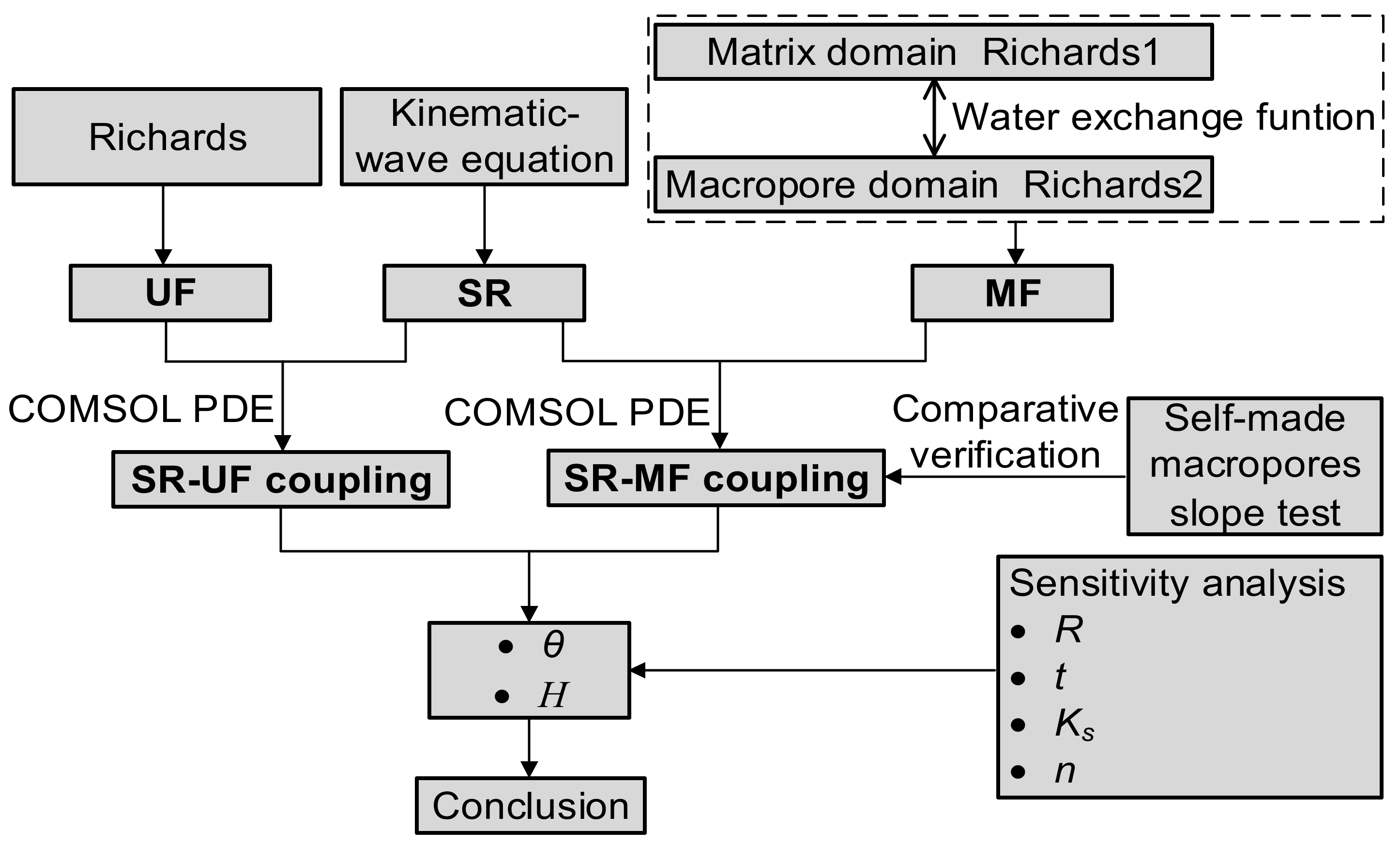

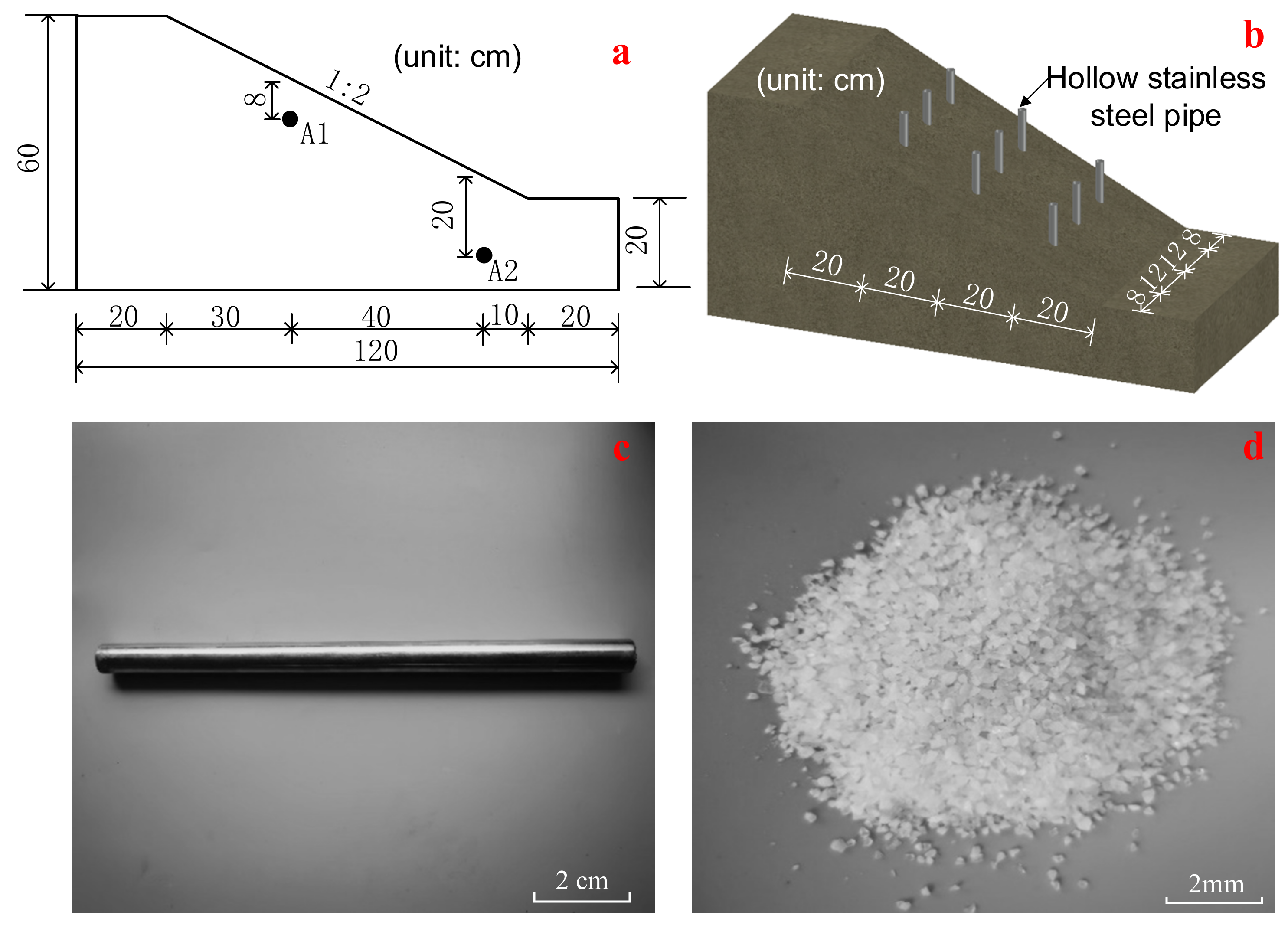


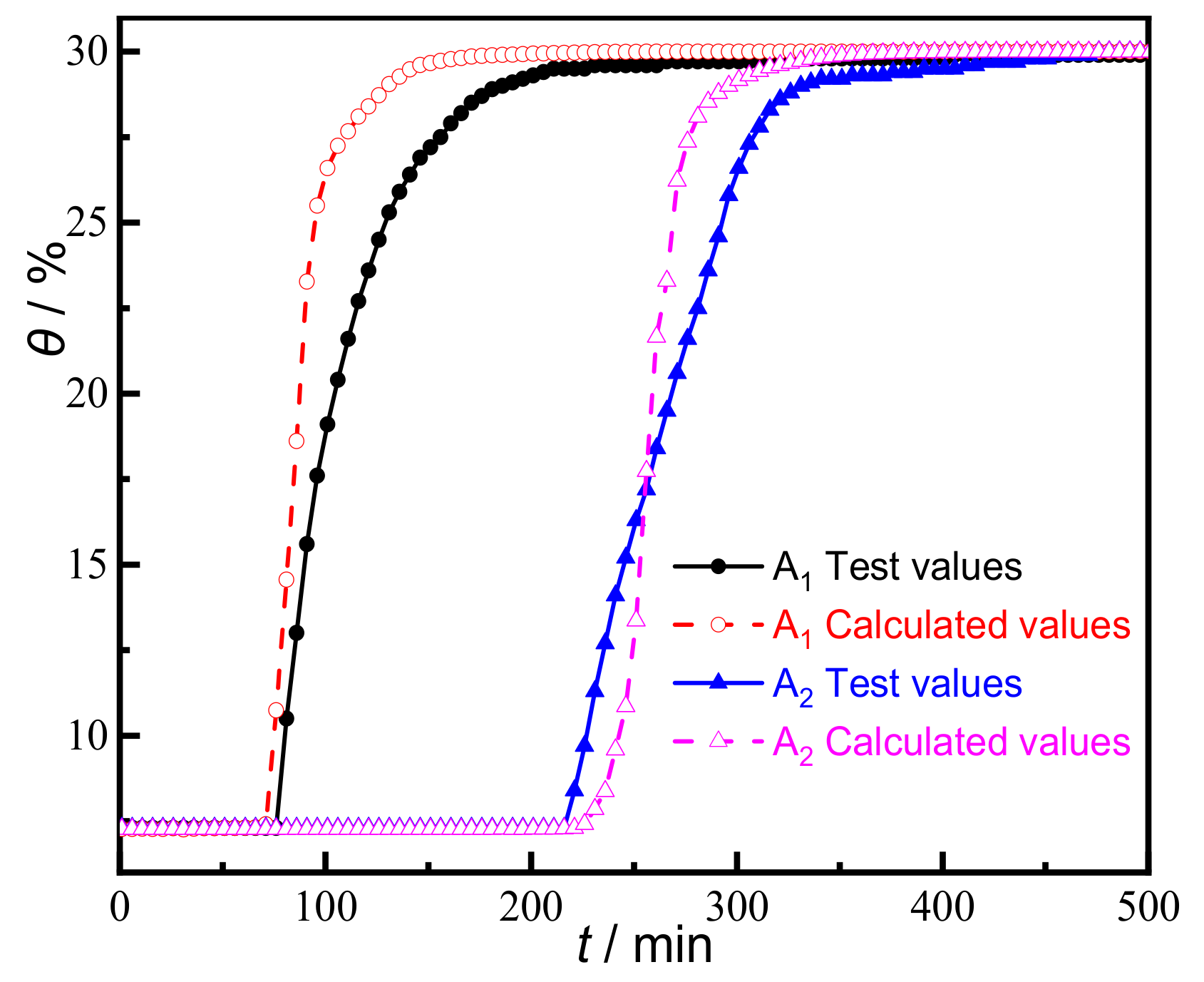
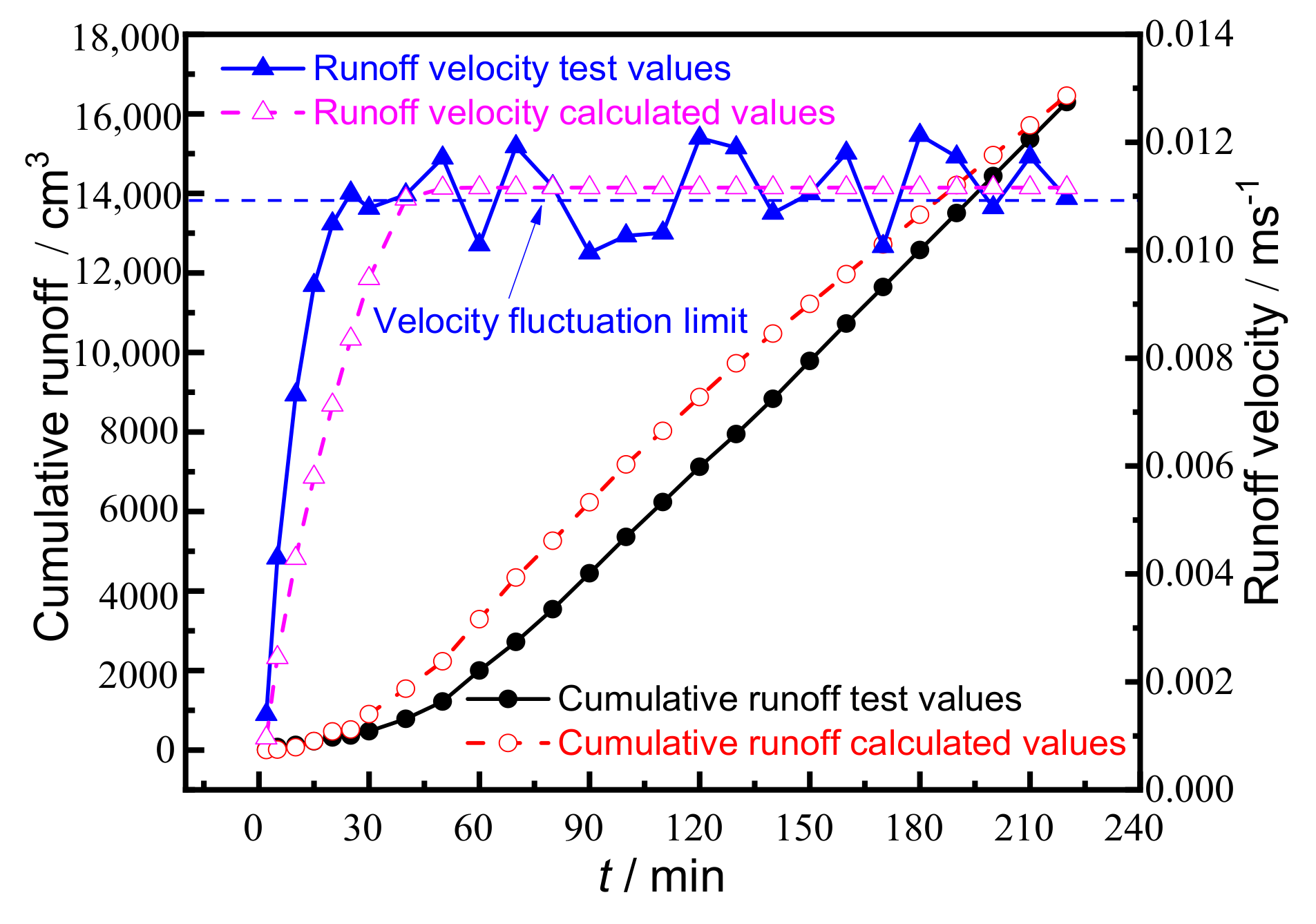
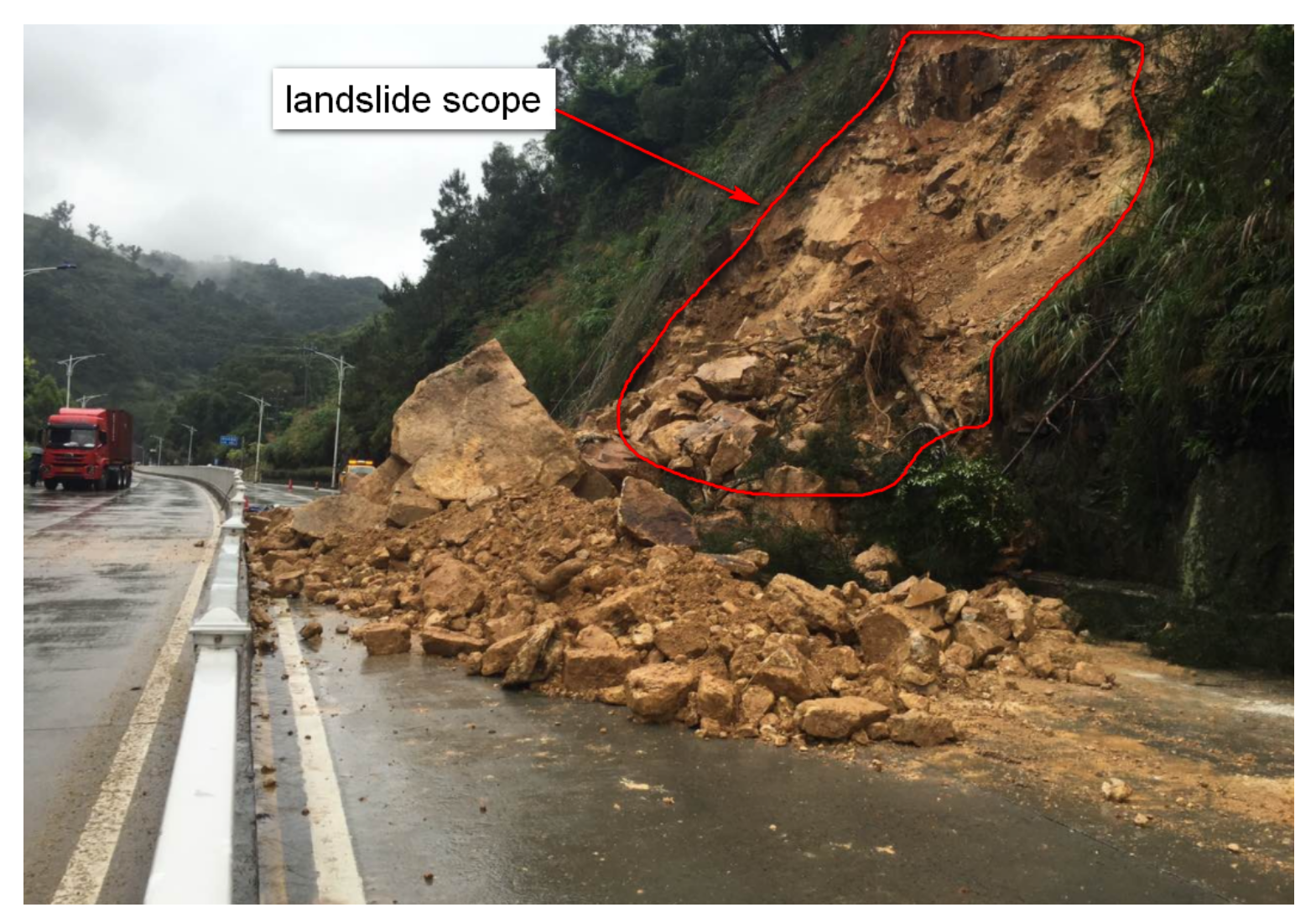

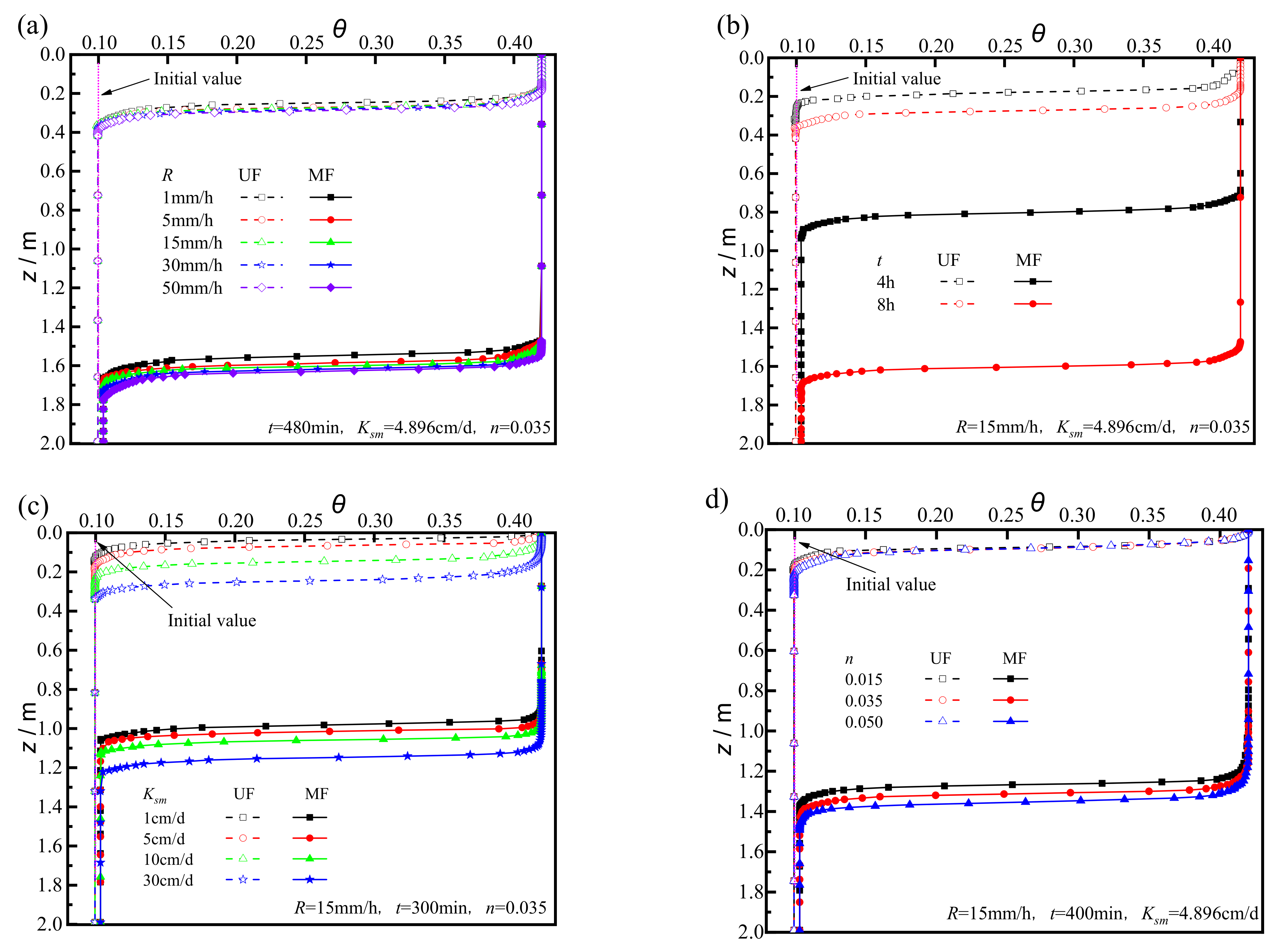
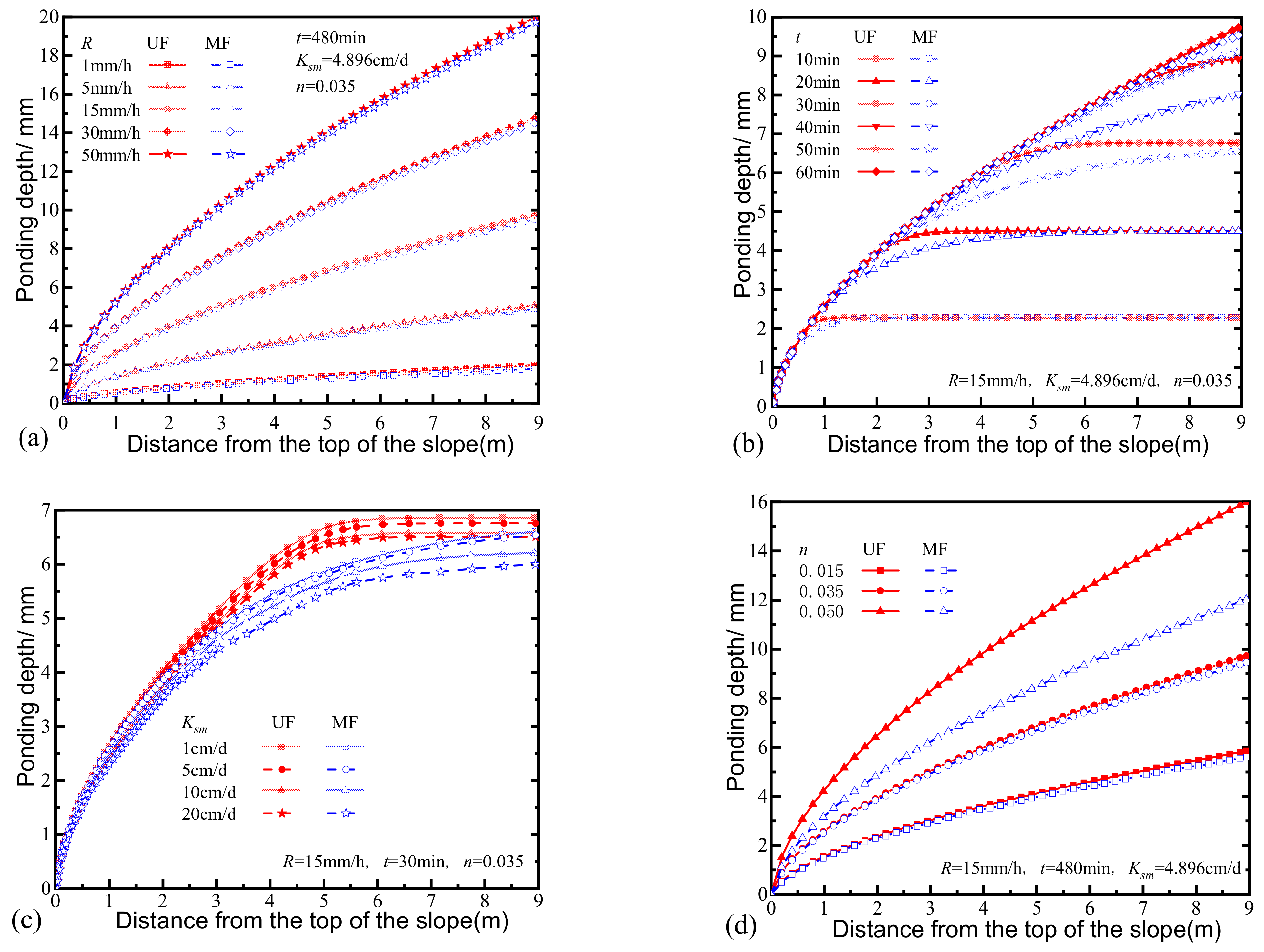
| Coefficient | ea | da | c | α | γ | β | ∇ | f | u |
|---|---|---|---|---|---|---|---|---|---|
| Equation (1) | 0 | 1 | 0 | 0 | 0 | 0 | 0 | Rcosφ – I − ∂q/∂x | H |
| Equation (2) | 0 | C | K | 0 | 0 | 0 | ∂(·)/∂x + ∂(·)/∂z | ∂K/∂z | h |
| Equation (3) | 0 | Cm | Km | 0 | 0 | 0 | ∂(·)/∂x + ∂(·)/∂z | ∂K/∂z + Γω/(1 − ωf) | hm |
| 0 | Cf | Kf | 0 | 0 | 0 | ∂(·)/∂x + ∂( ·)/∂z | ∂K/∂z − Γω/ωf | hf |
| Parameter | θr | θs | α (1/m) | n | l | Ks (cm/d) |
|---|---|---|---|---|---|---|
| Matrix domain | 0.029 | 0.421 | 5.76 | 1.5 | 0.5 | 4.896 |
| Macropores domain | 0 | 0.5 | 10 | 2 | 0.5 | 2113.7 |
Publisher’s Note: MDPI stays neutral with regard to jurisdictional claims in published maps and institutional affiliations. |
© 2021 by the authors. Licensee MDPI, Basel, Switzerland. This article is an open access article distributed under the terms and conditions of the Creative Commons Attribution (CC BY) license (https://creativecommons.org/licenses/by/4.0/).
Share and Cite
Li, S.; Jiang, Z.; Que, Y.; Chen, X.; Ding, H.; Liu, Y.; Dai, Y.; Xue, B. Water Field Distribution Characteristics under Slope Runoff and Seepage Coupled Effect Based on the Finite Element Method. Water 2021, 13, 3569. https://doi.org/10.3390/w13243569
Li S, Jiang Z, Que Y, Chen X, Ding H, Liu Y, Dai Y, Xue B. Water Field Distribution Characteristics under Slope Runoff and Seepage Coupled Effect Based on the Finite Element Method. Water. 2021; 13(24):3569. https://doi.org/10.3390/w13243569
Chicago/Turabian StyleLi, Shanghui, Zhenliang Jiang, Yun Que, Xian Chen, Hui Ding, Yi Liu, Yiqing Dai, and Bin Xue. 2021. "Water Field Distribution Characteristics under Slope Runoff and Seepage Coupled Effect Based on the Finite Element Method" Water 13, no. 24: 3569. https://doi.org/10.3390/w13243569
APA StyleLi, S., Jiang, Z., Que, Y., Chen, X., Ding, H., Liu, Y., Dai, Y., & Xue, B. (2021). Water Field Distribution Characteristics under Slope Runoff and Seepage Coupled Effect Based on the Finite Element Method. Water, 13(24), 3569. https://doi.org/10.3390/w13243569








